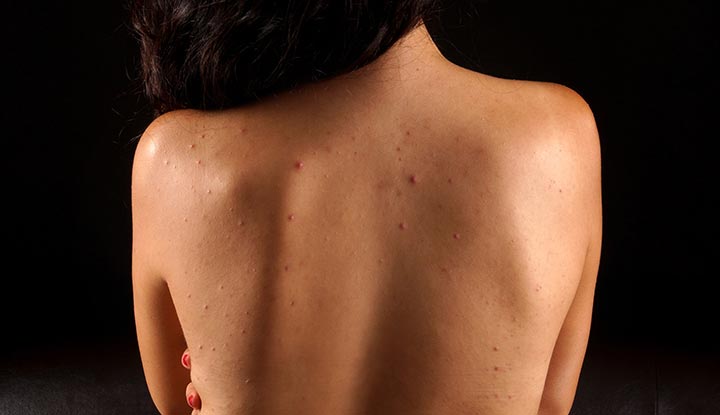Back acne (“bacne”) is acne that develops on your back. It happens when sweat, oil, dead skin cells and bacteria get trapped in your skin’s pores. Backpacks, sweaty shirts or sports equipment can create friction on your back and worsen back acne. You can treat back acne by keeping your skin clean and using acne-fighting skin creams.
Advertisement
Cleveland Clinic is a non-profit academic medical center. Advertising on our site helps support our mission. We do not endorse non-Cleveland Clinic products or services. Policy

Back acne (or “bacne”) is acne that develops on your back. It causes pimples that appear as red bumps, whiteheads or blackheads. These zits can be unsightly, annoying and painful.
Advertisement
Cleveland Clinic is a non-profit academic medical center. Advertising on our site helps support our mission. We do not endorse non-Cleveland Clinic products or services. Policy
Acne happens when oil, dirt, dead skin cells and bacteria clog your skin’s pores. Back acne usually results when sweat gets trapped under a shirt or athletic gear during exercise or strenuous activity. Clothing rubs against your sweaty skin, which leads to zits or makes them worse.
Several over-the-counter and prescription treatments can clear up back acne. But it may take a few months for skin to clear.
Anyone can get back acne. It can appear at any age and in people of all sexes. But it’s more common in teenagers and young men.
Acne is the most common skin condition in the United States. Around 50 million people in the U.S. have acne. It can develop anywhere on your body. Most often, acne appears on your face. But it’s also common on your back, shoulders, chest, neck and bottom.
Back acne develops like other types of zits. Your skin’s pores (tiny holes) get clogged with dirt, dead skin cells, sweat and an oil called sebum. Your body makes sebum to keep your skin and hair from getting too dry.
If your body makes too much sebum or you don’t clean your skin properly, you can get clogged pores. This can result from:
Advertisement
You may have pimples only along your shoulders and upper back. Or they may develop all over your back and torso down to your waist. These zits can be painful and may develop in clusters. You might have one type of pimple or a combination of:
You can usually recognize signs of back acne on your own. If you have a lot of pimples on your back or they keep coming back, see your healthcare provider. They’ll examine your skin. They may recommend seeing a dermatologist (a provider who specializes in caring for skin).
You can treat mild back acne at home. You should:
If back acne lingers or keeps coming back, see your dermatologist. They may recommend other prescription skin care products to treat severe acne. Or you may need antibiotics or other oral medications.
Most of the time, back acne gets better with at-home treatments. If these pimples don’t respond to over-the-counter products, dermatologists can treat severe back acne with prescription medications.
Depending on how many zits you have on your back, you may need to try different types of treatments. It might take several weeks for them to clear up. Your healthcare provider may recommend a combination of medications to get the results you want.
You may not be able to prevent back acne. But ask your healthcare provider if any medications you take (such as corticosteroids) may be causing back acne. You can also lower your risk of getting back acne by:
See your healthcare provider if:
Advertisement
Back acne can range from mildly annoying to very painful. These back zits can take time to treat, especially if you play a sport that requires you to wear heavy equipment or padding on your back. To prevent back acne, always clean your skin after you sweat and change into a clean, dry shirt after a workout. Also, try to limit the friction and pressure on your back by avoiding equipment that rubs against your skin. If back pimples are painful or they keep returning, see your healthcare provider.
Advertisement
Cleveland Clinic’s primary care providers offer lifelong medical care. From sinus infections and high blood pressure to preventive screening, we’re here for you.

Last reviewed on 04/15/2022.
Learn more about the Health Library and our editorial process.